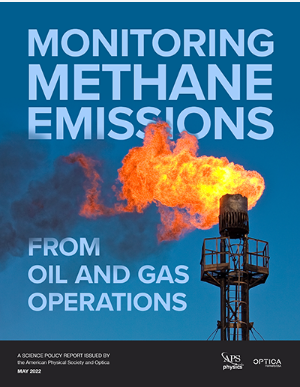Optica, American Physical Society release joint report on methane emissions
About Optica
16 May 2022
Optica, American Physical Society release joint report on methane emissions
The United States needs a comprehensive approach to tracking methane emissions
COLLEGE PARK, MD – The United States is not effectively monitoring methane emissions from oil and gas operations, but the federal government could take specific actions to remedy the situation, helping to address climate change, according to a new joint report by the American Physical Society (APS) Panel on Public Affairs and Optica (formerly OSA), Advancing Optics and Photonics Worldwide.

“Current methane monitoring under-estimates emissions from oil and gas by several times what it should be, and in order to fulfill any pledge to address climate change, the United States would need to consider a wide range of options to address the issue,” said William Collins, co-chair of the report, professor-in-residence at UC-Berkeley, and Director of the Climate and Ecosystem Sciences Division at Lawrence Berkeley National Laboratory.
“Developing methods for accurately measuring methane emissions is a global challenge. The Optica and APS communities are well-positioned to solve this challenge and enable the success of future monitoring efforts,” said Michelle Bailey, an author of the report, Research Chemist at the National Institute of Standards and Technology, and member of the Optica Public Affairs Council.
The atmospheric concentration of methane has more than doubled since the start of the Industrial Revolution. Colorless, odorless, and flammable, methane is the second most-abundant greenhouse gas generated by human activities. Methane has a 100-year global warming potential more than 30 times greater than carbon dioxide. Because methane remains in the atmosphere for about a decade—compared to centuries for carbon dioxide—actions taken today would have a significant positive impact in the short term.
The APS-Optica report provides a technical assessment of the current state of monitoring US methane emissions from oil and gas operations, which account for roughly 30% of US anthropogenic methane emissions. It also contains recommendations to inform investments in research to improve the nation’s detection capabilities and to strengthen monitoring policies throughout the United States. APS and Optica partnered on the study for more than a year, leveraging their scientific communities’ expertise in areas of remote sensing, modeling, and monitoring of greenhouse gasses from a variety of space-, air-, and land-based platforms. The report’s authors include experts from several national laboratories and universities. Independent experts also reviewed the study before its publication.
The study concludes that the United States is not effectively monitoring methane emissions because, in part, there are no calibration standards to enable the comparison of methane emissions data collected from different technologies. The report’s authors also maintain that a large portion of the total emitted methane from oil and gas operations originates from a small number of sources, such as leaks. Quickly identifying and mitigating large leaks could potentially reduce the costs of producing oil and gas while significantly reducing emissions. For methane emission regulation to be most effective, it should target the small portion of leaks that are major emitters.
To support emerging national and international efforts to reduce methane emissions, the report highlights seven recommendations that address: methane emissions detection, reliable and systematized data and models to support mitigation measures, and effective regulation.
Among the seven recommendations, APS and Optica identified two crucial first steps toward addressing climate change. The organizations urge the federal government to:
○ Establish national facilities for testing new technologies and intercalibrating methane measurements that would support a tiered and federated observational network.
○ Establish a unified national database of observations of methane concentrations and emissions open to the international climate community to help monitor progress toward emission reduction targets.
APS and Optica will host a webinar on May 24, 2022, 12:00 -1:00 p.m. ET with members of the report committee who will provide an overview of the report and its findings. Registration is open.
About APS
The American Physical Society is a nonprofit membership organization working to advance and diffuse the knowledge of physics through its outstanding research journals, scientific meetings, and education, outreach, advocacy, and international activities. APS represents more than 50,000 members, including physicists in academia, national laboratories, and industry in the United States and throughout the world. Read more:www.aps.org
About Optica
Optica, Advancing Optics and Photonics Worldwide, is the society dedicated to promoting the generation, application, archiving and dissemination of knowledge in the field. Founded in 1916, it is the leading organization for scientists, engineers, business professionals, students and others interested in the science of light. Optica's renowned publications, meetings, online resources and in-person activities fuel discoveries, shape real-life applications and accelerate scientific, technical and educational achievement. Discover more at: Optica.org
Media Contact
